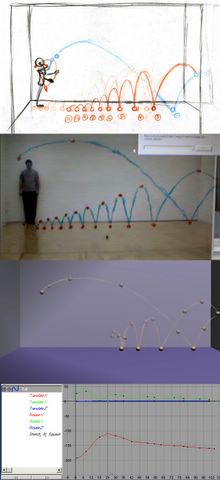Week 3: Evolution of a Shot

This was my first animation assignment, the first time I had to make something move. Getting up the courage to do it took longer than actually doing it. I didn't do my first draft til Wednesday, and it was horrible - really floaty, the timing and spacing were all way off. I went ahead and posted it on the AM site with a disclaimer, but people critiqued it anyway. Lesson learned: Don't put up sh*tty work, or people will tell you just how sh*tty it is.
So after that first horrible pass (which I'm keeping for posterity's sake), I quickly realized that I needed to put my brand new Canon ZR200 camcorder to use and film some actual reference. So David and I went to the racquetball courts and shot about 6 minutes of reference. That night I pulled out big wads of my hair trying to get the footage onto the computer, but finally got the issues resolved after calling Canon's support line the next day.
So after studying the footage frame by frame, I did a thumbnail drawing (top image) that followed the peaks of the arcs and where the ball made contact with the floor (usually just referred to as simply contacts) and then I drew in the arcs, literally connecting the dots. That gave me a good blueprint to start from.
I then opened a new scene in Maya, scrapping my original animation, and started setting keyframes at those contacts and highs. Then I remembered something Charles (my mentor) mentioned: DryErase markers. He just draws right on his screen all the time. So I got some of my own (see second image from the top) and found out exactly what those arcs looked like.
Something else I did was line up my video window directly over my Maya window so when I toggled between the two, the drawing on my screen would be in the same place on both video and my animation. Next I watched the video over and over, trying to time it out. I'm afraid my internal metronome is not working (that will be one of my next purchases: a metronome or stopwatch), so my animated interpretation was not very accurate. Now Charles advised against sliding the keys around to fix the timing because it cheats you from learning how to correctly time things. But the way I figure, I had to start somewhere, so I would make a guess as to where the ball should fall, play it back, and move it accordingly.
Then there was the graph editor I had to deal with (see bottom image). I'm not going to explain in too much detail (this entry is already technical enough), but suffice it to say that every keyframe that is set can be represented as a point on a graph. With this particular animation, I was dealing with two factors: how high the ball went (on the Y axis) and how far or close it went (on the X axis). The movement of the ball is dictated not only by these points, but by the curve created between these points. Luckily, the curves can be manipulated into different shapes by changing the angle of the tangents on either side of the points which in turn directly affect the nature of the movement.
Now efficiency is important in animation, especially on the computer - as that graph editor can quickly become a jumble of indecipherable curves. My main task was to figure out how to get this animation done in the fewest number of keyframes and still get convincing spacing and timing. Since I had 6 bounces, I knew I had to have at least 12 keys; 1 for the high (at the top of the bounce) and 1 for the low (the bottom of the bounce, or contact) - so after I set those positions and slid them around til I thought they were in the right places, I fiddled with the tangents to get the ball moving smooth on the arcs and really sharp and snappy at the contacts.
After I did all I could with that, I saw that I needed more hang time at the tops of the bounces, so I added 4 more keys to keep the ball up there longer after the last 4 bounces, and it was just perfect (to my imperfect eyes). Well, perfect enough to not be embarrassed showing it to my peers. Now I could only do 100 frames which at 24 frames per second (which is what film is projected at), that's just over 4 seconds of animation, which is why I didn't animate all 20 bounces the ball would have normally made.
You can see what I submitted to my mentor here. Now, after I was done with the ball, I went on to animate Stu actually throwing the ball, but things got confusing real quick. i got lost and found myself hacking through it - doing three versions and not getting satisfactory results with any of them.
So I'm glad we're starting out slow and simple - bouncing ball with no squash and stretch yet. I can't even imagine being able to make sense and keep track of keys on fully articulated characters. It's an overwhelming thought, but I'll get there eventually. My goal is to get to the point where Bobby (Beck) is at - where I'm animating from the inside out.
But for now, I have to wrap my head around this keyframe business. Enough to give you a migraine, I tell you.


0 Comments:
Post a Comment
<< Home